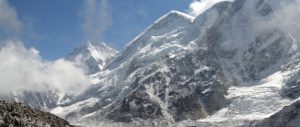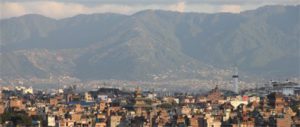Glacial lakes in the Himalayas could pose a major hazard to population centres if they are ruptured by earthquakes, scientists say. The true risk to settlements and infrastructure downstream in the Hindu Kush-Himalayan region is difficult to assess. But the Himalayan region is dotted with glacial lakes and is in a seismically active zone. Experts say that, on the basis of past records, a large quake in the region is overdue.
Many glacial lakes are said to be growing – some of them alarmingly fast – because of melting glaciers. Some are at risk of rupturing, which would flood areas downstream. There have been at least 35 glacial lake outburst events in Nepal, Pakistan, Bhutan and China during the last century, according to the United Nations Environment Programme (UNEP). But the increased risk from the quake-induced rupture of glacial lakes has been rarely discussed.
“Such a disaster is very much possible, more so, when we are expecting a big earthquake in the region now,” says Sushil Kumar, a geophysicist with the Wadia Institute of Himalayan Geology in India. “If the acceleration is very high in the epicentre of the earthquake, everything will be in the air as things will not be stable. So, naturally, the liquids like waters in glacial lakes will burst out.”
A number of these lakes are located near seismic faults. “Given the location of the lakes, if the epicentre of the earthquake happens to be nearby them, they will certainly explode,” says Pradeep Mool, a glaciologist with the International Centre for Integrated Mountain Development (ICIMOD), which works on mountain issues in the region.
A recent report produced by ICIMOD, together with the World Bank and the Global Facility for Disaster Reduction and Recovery, has also said that such a hazard “is a possibility that should be considered, although prediction [of earthquakes] is beyond current competence.”
Officials with Nepal’s National Seismological Centre (NSC) say at least half a dozen minor tremors are recorded in the Himalayas every day. “And when the tremor is [magnitude] five or above… we record many aftershocks as well,” says Dilliram Tiwari of the NSC. “We know that these activities are happening in the Himalayas but we cannot confirm if they are happening nearby any glacial lakes.” That is because hardly any seismic meters are installed near glacial lakes.
The danger is not just from the lakes that are filling up. Landslides and avalanches can make even smaller lakes dangerous, especially during earthquakes, experts say. For instance, the outburst of the Dig Tsho glacial lake near Mount Everest in eastern Nepal in 1985 was triggered by a large ice and rock avalanche. The splash into the relatively small lake led to an outburst. The floodwaters swamped a hydroelectric plant and other infrastructure downstream.
Tsho Rolpa is one of Nepal’s most monitored glacial lakes. The lake is risky not just because of its growing size and weak moraine, but also because it has two hanging glaciers high above it. “In case of earthquakes, glaciers such as these can make the glacial lakes like Tsho Rolpa even more dangerous because of the possibility of splash and surge,” says Mool.
Although not created by glacial melting, a lake that formed after a landslide blocked the Hunza river in Pakistan last year was caused by an earthquake, says professor Asif Khan, a geologist with Peshawar University in Pakistan. What has happened in these lower parts of the Hindu Kush-Himalaya could also occur in higher areas with glacial lakes, he warns.
“The main reason why we have not yet witnessed the outburst of glacial lakes because of earthquakes is because the region has not been hit by big ones in recent decades,” says Sushil Kumar of the Wadia Institute of Himalayan Geology. “And when the last earthquakes hit the region, there were barely any glacial lakes in the Himalaya region.” Glaciologists say the round of glacial melting leading to the formation of most new glacial lakes in the Himalayas began in the 1950s. The last big earthquake to hit the region was in 1934.
A recent report on Nepal’s glacial lakes said their average area had increased by 33%. “A great number of people are potentially in danger should the lakes classified as dangerous in the Hindu Kush Himalayas drain,” says another report by UNEP. “In most cases, there would be little or no warning, with insufficient time for complete evacuation.”
But studies have so far focused only on retreating glaciers and expanding glacial lakes. “They have not been monitored in relation to seismicity,” says Khan. “It is indeed quite worrying given the scale of the impending risk.”
Navin Singh Khadka is a journalist with the BBC Nepali service. He has a sustained interest in environment, with a focus on climate change vis-a-vis Himalayan ecology.
An earlier version of this article appeared on the BBC Science and Environment website. It is reproduced here with permission.
Homepage image from Bikas Rauniar/Department for International Development shows the melting Thulagi glacier in Nepal.


